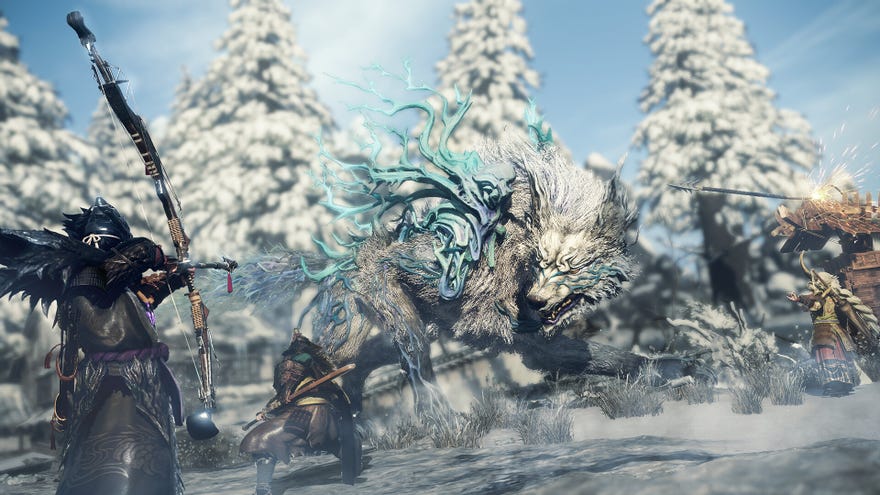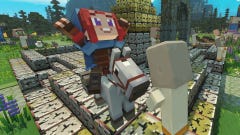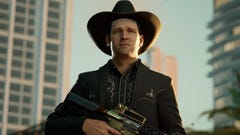Wild Hearts review: an impressive monster battler that's perfect for beast-brawling newcomers
But beware the stuttersaurus that eats PC players alive
There’s a touch of poetry to the way Wild Hearts carves so liberally from Monster Hunter. After all, Monster Hunter is a series about an unknown newcomer toppling ancient beasts, chopping up their best bits to create weapons and armour. Forget sleeves, Wild Hearts wears its inspirations as a complete set of clothing crafted from the bones, fur, and teeth of Capcom’s increasingly popular series. Inevitably these materials may feel lesser than the whole from which they were harvested, but they are worn proudly and with confidence nevertheless.
Besides, as a rare challenger to Monster Hunter, Wild Hearts is clearly aware of the difficulties involved in trying to pull off something new. Perhaps this is why Omega Force’s monster battler is so welcoming to newcomers. Finally, here is a game that is willing to teach a player why this long-running genre is held in such high regard. Wild Hearts is the perfect entry point for anyone who has ever dreamed of being a Monster Hunter Liker. A bombastic, brilliant good time that’s held back by frequent, frustrating performance issues on PC.
Wild Hearts is all about killing monsters, or hunting them if you will. The village of Minato is under constant threat from ferocious Kemono, enormous creatures that wreck the environment around them with little care for the human structures they destroy as a result. These huge pigs, chickens, porcupines, squirrels and abunch of other critters are not docile or peaceful but extremely dangerous. As a hunter, you are the one thing preventing Minoto from being completley squashed by a giant tree branch wrenched out of the ground by a fire-breathing gorilla.
Battles follow a strict loop. You choose which beast you’d like to brawl from a map, then after some tracking you'll find the monster, who will proceed to muster everything in its power to ensure you have an absolutely terrible time. Fights are tense and chaotic, frequently stretching past the 20-minute mark as you desperately attempt to fell this humongous creature without the comforting aid of a health bar letting you know how close you are to your goal. There is a rhythm to combat, a balance and a beat in your dance of death. In small pockets of calm you'll guzzle down health juice, and so too will the monster retreat to its lair to lick its wounds as you both prepare for your next encounter. After tracking it again and eventually dealing the final blow, the battered carcass can be harvested for precious upgrade materials that will aid you in your future monster bashing endeavours.

This will, of course, all sound very familiar to anyone who’s played Monster Hunter before. Structurally the two are near identical, but why fix what isn’t broken? Repetition and routine are what make Monster Hunter so compelling, and by lifting that formula wholesale from its competitor, Wild Hearts has succeeded in capturing that same magic. Yes, you will hunt the same monster multiple times. It will attack you with the same moves. You will get knocked down again, again, and again. But fret not. Above all else, your goal here is mastery. Not a cool new pair of boots, or a hat made out of a raccoon’s face. Mastery. The ability to predict what a monster will do next, and counter it without taking a hit. That was the joy of Monster Hunter, and it can be found just as easily in Wild Hearts.
Of course, things aren’t entirely the same. The biggest difference comes in the form of Karakuri, an ability that allows your hunter to summon boxes and tools out of thin air using a harvestable resource called Thread. These trinkets serve as your special moves and allow you to both counter and deal damage to Kemono. One Karakuri lets you stack a bunch of crates, allowing you to perform a devastating jump attack by leaping from the top of them. A spring carries you safely out of the path of a charging monster. A tiny helicopter lets you glide gracefully above the chaos before plunging your sword into a creature’s exposed brain.
Trying to brawl a beastie whilst whipping together a Karakuri is fiddly to get to grips with at first, but quickly becomes second nature. It helps that more complicated constructions - created by combining different base types of Karakuri - are drip fed to the player gradually as you progress through the main story. Before long you’re building bombs, wobbly hammers and reinforced walls that knock enemies back and send them flying through the air like a punctured Thanksgiving parade balloon.

Whacking a big pig with a hammer made me laugh throughout my entire time with the game. The simple joke of a huge wooden mallet bonking an unsuspecting creature on the noggin’ never gets old. Karakuri make fights more dynamic and interesting, sure, but they also make them more fun which is just as important. They can be used outside of battle, too, letting you access more permanent structures so you can carve shortcuts into the game’s open spaces. These Dragon Karakuri - as they’re referred to in the game - aren’t as exciting as the trinkets you use in battle, but they allow you to make your mark on what would otherwise be little more than a twisty combat arena.
Monsters don’t show up on your map automatically and must be found via wooden radio towers you can place anywhere within a level. You can also create your own spawn points by building camps complete with a cosy campfire that lets you initiate hunting missions. Building a forge when you're out and about also lets you upgrade equipment without having to trudge all the way back to the hub village. They're minor additions, but it deepens the relationship you form with these areas, places that you'll inevitably end up returning to repeatedly throughout your time with Wild Hearts.

Perhaps unsurprisingly, the bombastic combat shares similarities with the developer’s hack-and-slash series Dynasty Warriors. Weapons are satisfying and weighty, bolstered by impressive animation work and inventive attack design, but ultimately lack depth beyond a few basic combos. This isn’t necessarily an issue as Karakuri offer some additional complexity, but those looking to master a specific blade may find their options a little limited. A selection of knottier weapons are unlocked at the halfway point - such as an excellent cannon that lets you lay waste from a distance - but again, these can be mastered with significantly less investment than anything found in Monster Hunter.
I don’t think this is a bad thing, mind. It speaks to the game’s commitment to serve as the best introduction to lower case monster hunting to date. Distinctly separate from the 19-year-old series it cribs from so heavily, Wild Hearts is able to onboard new players in a way that feels friendly and patient. Tutorials are contextualised through narrative missions that see you battling smaller monsters with a limited selection of weapons and Karakuri. Gradually the game introduces slightly more complex systems such as elemental effects, weapon upgrading, and the importance of eating before a fight in a way that feels lean and digestible. There’s very little bloat to be found here, which is a breath of fresh air when compared to the density of the more recent Monster Hunter titles. If you’ve always fancied punching a big chicken in its ribs but were put off by Rise’s seemingly endless drudgery of text-based tutorials, Wild Hearts may well be the first step you’ve been searching for.
Still, as is so often the case with a first attempt, Wild Hearts is not without its flaws. Monster designs are brilliant and expressive (their rage forms, which cause trees and other flora to erupt from the earth as they roar with anger, a particular highlight) but variation is unfortunately limited. This will no doubt change as inevitable DLC packs or sequels are released, but as it stands a few additional monsters wouldn’t have gone amiss. The same can’t be said for the game’s story, which probably could have benefited from being scaled back. Things happen and people talk to you about them, but the actual content of these conversations and events is so bland and uninteresting that I genuinely can’t recall a single thing that happens. The fact you’re infrequently presented with a dialogue choice is laughable. It literally doesn’t matter, and the wider story can be summarised as “go and punch those monsters before they turn around and punch you”.

Then, of course, there are the tech issues. We’ve covered them quite extensively on the site already, but it bears repeating: Wild Hearts performs poorly on PC as a result of issues surrounding a CPU bottleneck. Hitting a consistent frame rate - even on high end hardware - is impossible. The game stutters constantly. Pop-in is atrocious. Motion blur and depth of field, enabled by default, actively make the game look worse. To add insult to injury, Omega Force acknowledged these issues before the game launched, but has yet to offer any kind of substantial fix a week after release. To top it off, Wild Hearts runs great on consoles, making the PC version feel even more borked. If it weren't for these issues, nothing would hold me back from slapping the game with an RPS 'bestest best' badge.
Even with the stuttering though, I adored my time with Wild Hearts. This is a fierce competitor to Monster Hunter and a great starting point for newcomers to the genre. A small part of me suspects that a sequel will see the game’s ideas coalesce in a way that makes Wild Hearts essential, but even in this slightly rough form, Omega Force has created one of the finest games of the year so far.


















